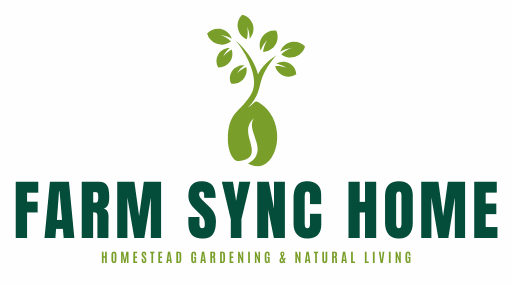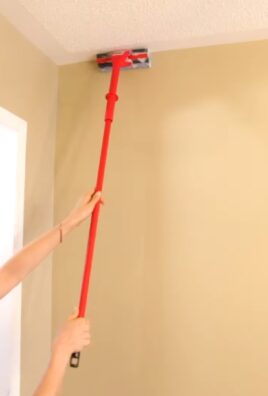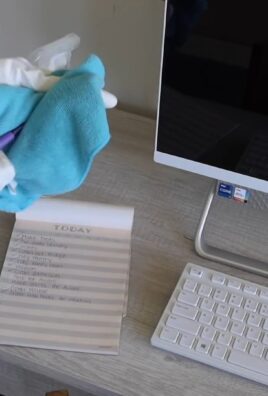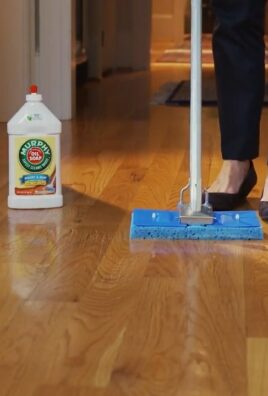Easy cleaning hacks for home – who doesn’t want them? Let’s be honest, cleaning isn’t exactly anyone’s favorite pastime. It’s a chore that often feels endless, a constant battle against dust bunnies and grime. But what if I told you there’s a way to make the whole process faster, easier, and even… dare I say… a little bit fun?
For centuries, people have been searching for clever shortcuts to maintain a tidy home. From ancient Roman bathhouses meticulously scrubbed with natural ingredients to the Victorian era’s obsession with spotless parlors, the desire for a clean living space is deeply ingrained in our history. But in today’s fast-paced world, we need solutions that fit our busy lifestyles. We don’t have hours to dedicate to scrubbing and polishing!
That’s where these easy cleaning hacks for home come in. I’m going to share some of my favorite DIY tricks that will save you time, money, and a whole lot of elbow grease. These aren’t your grandma’s cleaning methods (although, some of them are inspired by her wisdom!). These are practical, effective solutions using everyday items you probably already have in your pantry. Get ready to transform your cleaning routine and reclaim your weekends!

Easy Cleaning Hacks to Revolutionize Your Home Routine
Hey there, fellow cleaning enthusiasts! Let’s face it, cleaning isn’t exactly anyone’s favorite pastime. But what if I told you there are some super simple, game-changing hacks that can make your cleaning routine faster, easier, and even a little bit fun? I’ve compiled some of my absolute favorite DIY cleaning tricks that use everyday items you probably already have at home. Get ready to say goodbye to endless scrubbing and hello to a sparkling clean home!
Cleaning Your Microwave Like a Pro
Microwaves – they’re lifesavers for reheating leftovers, but they can quickly become a splattered, sticky mess. Forget harsh chemicals and endless scrubbing. This hack is all about steam power!
What You’ll Need:
* 1 cup of water
* 1/2 cup of white vinegar (or lemon juice)
* Microwave-safe bowl
* Clean sponge or cloth
Step-by-Step Instructions:
1. Mix the Solution: In your microwave-safe bowl, combine the water and vinegar (or lemon juice). The vinegar helps to loosen grime, while the lemon juice adds a fresh scent.
2. Microwave Magic: Place the bowl in your microwave and heat it on high for 5-7 minutes. You want the solution to boil and create steam inside the microwave.
3. Steam Clean: After the timer goes off, don’t open the microwave door immediately! Let the steam work its magic for another 2-3 minutes. This allows the condensation to loosen all the stuck-on food particles.
4. Wipe Away the Mess: Carefully remove the bowl (it will be hot!). Use your clean sponge or cloth to wipe down the inside of the microwave. You’ll be amazed at how easily the grime comes off! For stubborn spots, you might need a little extra elbow grease, but it should be significantly easier than before.
5. Final Touches: Wipe down the microwave door and the outside. And that’s it! A sparkling clean microwave in under 10 minutes.
De-Gunking Your Showerhead for Better Water Pressure
Is your showerhead sputtering and spraying in all directions? Mineral buildup is likely the culprit. This simple hack will restore your showerhead to its former glory.
What You’ll Need:
* White vinegar
* Plastic bag (a sandwich bag works well)
* Rubber band or twist tie
* Old toothbrush (optional)
Step-by-Step Instructions:
1. Vinegar Bath: Fill the plastic bag with enough white vinegar to completely submerge the showerhead.
2. Secure the Bag: Carefully attach the bag to the showerhead using the rubber band or twist tie. Make sure the bag is securely fastened so the vinegar doesn’t leak.
3. Soak Overnight: Let the showerhead soak in the vinegar overnight (or for at least a few hours). The vinegar will dissolve the mineral deposits that are clogging the showerhead.
4. Scrub Away Residue: Remove the bag and run the shower for a few minutes to flush out any remaining vinegar and loosened debris. If you still see some stubborn buildup, use an old toothbrush to gently scrub it away.
5. Enjoy the Pressure: Enjoy your revitalized showerhead with improved water pressure!
Cleaning Your Blender Like a Pro
Cleaning a blender can be a pain, especially after making a thick smoothie or sauce. This hack makes it a breeze!
What You’ll Need:
* Dish soap
* Water
Step-by-Step Instructions:
1. Fill It Up: Immediately after using your blender, fill it about halfway with warm water.
2. Add Soap: Add a squirt or two of dish soap.
3. Blend Away: Secure the lid and blend on high speed for about 30-60 seconds.
4. Rinse Thoroughly: Pour out the soapy water and rinse the blender thoroughly with clean water.
5. Air Dry: Let the blender air dry completely before storing it.
This hack works because the soapy water helps to loosen any food particles that are stuck to the blades and the sides of the blender. Blending it all together ensures that every nook and cranny gets cleaned.
Reviving Your Grout with Baking Soda Paste
Dirty grout can make even the cleanest tiles look dingy. This baking soda paste is a natural and effective way to brighten your grout lines.
What You’ll Need:
* Baking soda
* Water
* Old toothbrush
* Spray bottle (optional)
* White vinegar (optional)
Step-by-Step Instructions:
1. Make the Paste: In a small bowl, mix baking soda with enough water to form a thick paste.
2. Apply the Paste: Apply the baking soda paste to the grout lines using your fingers or a small spatula.
3. Scrub Away: Use an old toothbrush to scrub the grout lines vigorously. Focus on areas with heavy staining.
4. Rinse Thoroughly: Rinse the grout lines with clean water. You can use a spray bottle to make rinsing easier.
5. Optional Vinegar Boost: For extra cleaning power, you can spray the grout lines with white vinegar after scrubbing with the baking soda paste. The vinegar will react with the baking soda, creating a fizzing action that helps to lift away stubborn dirt and grime. Let it fizz for a few minutes, then rinse thoroughly with water.
Unclogging Drains Naturally
Clogged drains are a common household problem. Instead of reaching for harsh chemical drain cleaners, try this natural solution.
What You’ll Need:
* 1/2 cup baking soda
* 1 cup white vinegar
* Boiling water
Step-by-Step Instructions:
1. Pour in the Baking Soda: Pour 1/2 cup of baking soda down the drain.
2. Add the Vinegar: Follow with 1 cup of white vinegar.
3. Let it Fizz: Let the mixture fizz and bubble for about 30 minutes. This reaction helps to break down the clog.
4. Flush with Boiling Water: After 30 minutes, carefully pour a pot of boiling water down the drain. The hot water will help to flush away the loosened debris.
5. Repeat if Necessary: If the drain is still clogged, repeat the process. For particularly stubborn clogs, you may need to use a plunger after flushing with boiling water.
Cleaning Your Cutting Boards Effectively
Cutting boards can harbor bacteria if not cleaned properly. Here’s how to disinfect them naturally.
What You’ll Need:
* Lemon
* Coarse salt (sea salt or kosher salt)
* Clean sponge or cloth
Step-by-Step Instructions:
1. Sprinkle with Salt: Sprinkle a generous amount of coarse salt over the surface of the cutting board.
2. Lemon Scrub: Cut a lemon in half and use one half to scrub the salt into the cutting board. The lemon juice acts as a natural disinfectant, while the salt helps to scrub away food particles and stains.
3. Rinse Thoroughly: Rinse the cutting board thoroughly with warm water.
4. Air Dry: Let the cutting board air dry completely before storing it.
This method works well for both wooden and plastic cutting boards. For wooden cutting boards, you can also rub them with mineral oil after cleaning to help prevent them from drying out and cracking.
Freshening Up Your Garbage Disposal
Garbage disposals can get pretty smelly over time. Here’s a simple way to freshen them up and keep them running smoothly.
What You’ll Need:
* Ice cubes
* Lemon or lime wedges
* Coarse salt
Step-by-Step Instructions:
1. Ice Cube Cleanse: Fill the garbage disposal with ice cubes.
2. Add Citrus and Salt: Add a few lemon or lime wedges and a handful of coarse salt.
3. Grind Away: Turn on the garbage disposal and let it run until all the ice cubes are ground up.
4. Flush with Water: Flush the garbage disposal with cold water for a few seconds.
The ice cubes help to scrub the inside of the garbage disposal, while the lemon or lime wedges add a fresh scent. The salt helps to break down any grease or food particles that are stuck to the blades.
Polishing Stainless Steel Appliances
Fingerprints and smudges can make stainless steel appliances look dull. This simple hack will restore their shine.
What You’ll Need:
* White vinegar
* Microfiber cloth
Step-by-Step Instructions:
1. Spray with Vinegar: Lightly spray the stainless steel appliance with white vinegar.
2. Wipe with the Grain: Use a clean microfiber cloth to wipe the appliance in the

Conclusion
So, there you have it! This simple yet incredibly effective DIY cleaning trick is more than just a quick fix; it’s a game-changer for maintaining a sparkling clean home without breaking the bank or relying on harsh chemicals. We’ve shown you how to harness the power of readily available ingredients to tackle common cleaning challenges, saving you time, money, and effort in the long run.
Why is this a must-try? Because it’s efficient, eco-friendly, and customizable. Store-bought cleaners often contain ingredients that can be harmful to your health and the environment. This DIY approach allows you to control exactly what goes into your cleaning solutions, ensuring a safer and healthier living space for you and your family. Plus, the satisfaction of creating something effective with your own hands is an added bonus!
But don’t stop there! Feel free to experiment with variations to suit your specific needs and preferences. For instance, if you’re dealing with particularly stubborn stains, try adding a tablespoon of baking soda to your cleaning solution for extra scrubbing power. Or, if you prefer a different scent, swap out the lemon essential oil for lavender, eucalyptus, or tea tree oil – all known for their antibacterial and antifungal properties. You can even infuse vinegar with citrus peels for a more pleasant aroma and added cleaning power. The possibilities are endless!
Remember, the key to success with any DIY project is to start small and adjust as needed. Test your cleaning solution on an inconspicuous area first to ensure it doesn’t damage the surface. And always wear gloves to protect your hands, especially when working with vinegar or other acidic ingredients.
We are confident that once you try this DIY cleaning trick, you’ll be amazed by the results. It’s a simple, effective, and sustainable way to keep your home clean and fresh. So, ditch the expensive store-bought cleaners and embrace the power of DIY!
Now, we want to hear from you! Have you tried this DIY cleaning trick before? What variations did you use? What were your results? Share your experiences, tips, and tricks in the comments below. Let’s create a community of DIY cleaning enthusiasts and help each other keep our homes sparkling clean! We encourage you to share this article with your friends and family so they can benefit from these easy cleaning hacks for home as well. Let’s make cleaning less of a chore and more of a fun and rewarding experience!
Frequently Asked Questions (FAQs)
1. Is this DIY cleaning solution safe for all surfaces?
While this DIY cleaning solution is generally safe for most surfaces, it’s always best to test it on an inconspicuous area first, especially on delicate or sensitive materials like wood, marble, or granite. The acidity of vinegar can potentially damage certain surfaces, so proceed with caution. For wood surfaces, consider diluting the solution further or using a specialized wood cleaner. For marble and granite, opt for a pH-neutral cleaner to avoid etching or discoloration. When in doubt, consult the manufacturer’s instructions for your specific surface.
2. Can I use this DIY cleaning solution on my electronics?
No, this DIY cleaning solution is not recommended for cleaning electronics. The liquid can seep into the internal components and cause damage. Instead, use a microfiber cloth lightly dampened with distilled water or a specialized electronic cleaner. Always unplug the device before cleaning and avoid spraying any liquid directly onto the screen or ports.
3. How long does this DIY cleaning solution last?
This DIY cleaning solution is best used fresh. While it can be stored for a few days in an airtight container, the effectiveness may diminish over time. The essential oils may also lose their potency. To ensure optimal results, we recommend making a fresh batch each time you clean. This also allows you to customize the solution based on your specific cleaning needs.
4. Can I use a different type of vinegar?
Yes, you can use different types of vinegar, such as apple cider vinegar or white wine vinegar. However, white distilled vinegar is generally preferred for cleaning due to its higher acidity and lack of color, which minimizes the risk of staining. Apple cider vinegar has a milder scent and may be a good option if you’re sensitive to the strong smell of white vinegar. Keep in mind that apple cider vinegar may leave a slight residue on some surfaces, so you may need to rinse with water after cleaning.
5. What if I don’t have essential oils?
Essential oils are not strictly necessary for this DIY cleaning solution, but they add a pleasant scent and can provide additional antibacterial and antifungal benefits. If you don’t have essential oils, you can simply omit them or substitute them with a few drops of your favorite fragrance oil. Alternatively, you can infuse the vinegar with citrus peels or herbs for a natural fragrance.
6. Can I use this DIY cleaning solution to clean my bathroom?
Yes, this DIY cleaning solution is excellent for cleaning bathrooms. It can effectively remove soap scum, mildew, and hard water stains from showers, tubs, sinks, and toilets. For stubborn stains, you can create a paste of baking soda and water and apply it to the affected area before spraying with the cleaning solution. Remember to ventilate the bathroom well while cleaning.
7. Is this DIY cleaning solution safe for pets and children?
While this DIY cleaning solution is generally safer than store-bought cleaners, it’s still important to exercise caution when using it around pets and children. Keep the solution out of reach and avoid spraying it directly on them. If your pet or child accidentally ingests the solution, contact a veterinarian or poison control center immediately.
8. How often should I use this DIY cleaning solution?
The frequency of use depends on your cleaning needs and preferences. You can use this DIY cleaning solution as often as you like to maintain a clean and fresh home. For high-traffic areas or surfaces that get dirty quickly, you may need to clean them more frequently.
9. Can I use this DIY cleaning solution to clean my laundry?
Yes, vinegar is a great natural laundry booster and can be used to soften clothes, remove odors, and brighten whites. Add about half a cup of white vinegar to your washing machine during the rinse cycle. However, avoid using vinegar with bleach, as the combination can create harmful fumes.
10. What are some other easy cleaning hacks for home that I can try?
There are many other easy cleaning hacks for home that you can try using readily available ingredients. For example, you can use baking soda to deodorize your refrigerator, clean your oven, or unclog drains. You can also use lemon juice to remove stains from cutting boards, polish copper, or clean your microwave. With a little creativity and resourcefulness, you can keep your home sparkling clean without spending a fortune on expensive cleaning products.





Leave a Comment